Abstract: Current transformers can be used to detect unipolar current pulses in high frequency switching power supplies. The working process of the current detecting circuit composed of the current transformer is analyzed. The characteristics of self-reset and forced reset of the core are compared. The test results are given.
Key words: current transformer; core reset; switching power supply
1 Introduction
In the high-frequency switching power supply, it is necessary to detect the current of the switching tube, the inductor, and the like to be supplied to the control and protection circuit. Current sensing methods include current transformers, Hall elements, and direct resistance sampling. Using Hall element sampling, the control and the main power circuit are isolated, the DC signal can be detected, the signal reductiveness is good, but there is a delay of μs level, and the price is relatively expensive; the price of the resistor sampling is very cheap, and the signal reductiveness is good, but The control circuit and the main power circuit are not isolated, and the power consumption is relatively large.
Current transformers have many advantages such as low energy consumption, frequency bandwidth, good signal reduction, low price, control and main power circuit isolation. In Push-Pull, Bridge and other double-ended converters, the power transformer primary side flows through positive and negative symmetrical bipolar current pulses, and there is no DC component, and the current transformer can be well applied. However, in single-ended applications such as Buck and Boost, the unipolar current pulse flows through the switching device; the DC component contained in the primary side cannot be reflected in the secondary side detection signal, and the current transformer core may be unidirectionally saturated. For this purpose, some improvements are needed to the detection circuit formed by the current transformer.
2 Application Circuit Analysis of Current Transformer Detecting Unipolar Current Pulse
Depending on the current transformer core reset method, there are two circuit types: self-reset and forced reset. After resetting, after the current pulse of the primary side of the current transformer disappears, the negative voltage generated by the open circuit impedance of the secondary side of the current transformer is reset by the excitation current. The magnitude of the reset voltage is related to the excitation current and the open circuit impedance of the current transformer. The forced reset circuit adds a large reset voltage during the disappearance of the primary DC pulse to achieve a quick reset of the core in a short time.
2.1 Current transformer detection circuit
The commonly used current transformer detection circuit is shown in Figure 1(a).
Figure 1(b) shows the equivalent circuit when there is a current pulse on the primary side. The current transformer is simplified to the ideal transformer and magnetizing inductance Lm model, and Rs is the sampling resistor.
When the duty ratio D<0.5, after the current pulse of the primary current of the current transformer disappears, the magnetic core generates a negative volt-second value by the excitation current flowing through the sampling resistor Rs to realize self-reset [Fig. 1(d1)~(i1) )), because the sampling resistor Rs is small, the negative reset voltage is small; when the current pulse duty cycle is large (D>0.5), the reset time is short, there is not enough reset volt-second value, so that the magnetic The DC component Id in the core increases, which may cause the magnetic core to gradually become positively biased (as shown in Figure 1 (d2) ~ (i2)), and lose the detection function, so the self-reset can only be applied to the current pulse duty. When the ratio is D<0.5.

(a) Detection circuit
(b) equivalent circuit when there is a pulse on the primary side
(c) Equivalent circuit when the core is reset
Figure 1 Analysis of common current transformer detection circuits
It can be seen that this circuit has a number of disadvantages for detecting unipolar DC pulses. The DC component Id exists in the magnetizing inductor current im, which tends to cause the core to saturate. The output voltage signal uR is bipolar and is not convenient for subsequent stage circuit processing.
2.2 Improved self-reset current transformer
In order to realize the unipolar output of the output voltage uR, a diode is added to the current transformer end. According to the difference between the phase of the primary input current i1 and the output voltage uR and the position of the signal, there are four circuit configurations, such as Figure 2 shows.
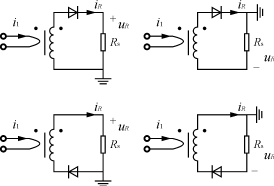
Figure 2 Improved current transformer detection circuit
The circuit operation process of Figure 2(c) is analyzed. The operating waveform of the circuit in one pulse period is shown in Figure 3.
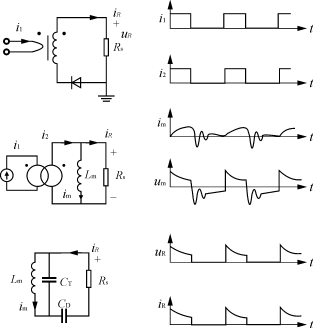
(a) Detection circuit
(b) equivalent circuit when there is a pulse on the primary side
(c) Equivalent circuit when the core is reset
Figure 3 Improved current transformer detection circuit analysis
Figure 3 (c) shows the equivalent circuit when the current transformer core is reset, CT is the secondary transformer distributed capacitance of the current transformer, and CD is the diode junction capacitance. Figures 3(d) to (i) plot the various parameter waveforms with a small duty cycle and a sufficiently reset core.
After the current pulse of the current transformer disappears, the reset of the core relies on the excitation current to generate a negative reset voltage value in Lm, CT, CD, and realize self-reset, as shown in Fig. 3(g). The characteristic impedance of the resonant circuit composed of Lm and CT is much larger than Rs, so the reset effect is better than that of the circuit of Fig. 1. However, the reset voltage generated by the resonance is not very large. When the pulse duty ratio is large, the reset time is short, and the core may be gradually positively biased, so it can only be applied to the current pulse duty cycle. Where D < 0.5.
Because the number of turns of the secondary side of the transformer is large, the distributed capacitance is large, the resonant current mainly flows from the current transformer; the current flowing through the Rs and CD branches is small, and Rs is small, so the reset current is resonated through the CD branch. The negative voltage generated by the current on Rs is negligible, and the sampled output voltage uR waveform is shown in Figure 3(h). Because of the action of the diode, the output voltage signal uR is unipolar, and its amplitude is proportional to the pulsation of the primary side current signal, which is convenient for the subsequent stage circuit processing.
2.3 Forced reset
In single-ended applications, particularly Boost circuits, it is desirable to accurately reproduce unipolar pulses of high duty cycle. Self-reset cannot detect high duty cycle current pulses, and the core must be forced reset. There are many circuits for forced reset, and here is a simple and easy forced reset circuit. As shown in FIG. 4, they correspond to the four circuits in FIG. 2, respectively.
Analyze the circuit working process of Figure 4(c). Figure 5(b) shows the equivalent circuit when there is a current pulse on the primary side. Due to the isolation of the diode, the reset voltage +Vr has no effect on the current detection. Fig. 5(c) shows an equivalent circuit at the time of core reset. The working waveform of the circuit in one pulse period is shown in Fig. 5(d)~(i). The primary side has a DC pulse from 0 to t1, the time from t1 to t2 is the core reset process, and t2~T is the waveform after reset. .

Figure 4 Forced reset current transformer detection circuit
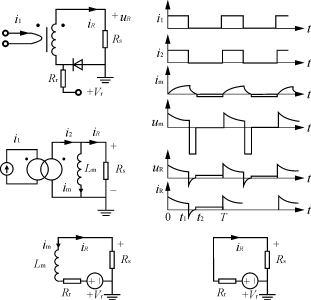
(a) Detection circuit
(b) equivalent circuit when there is a pulse on the primary side
(c) Equivalent circuit when the core is reset
(j) Effect of reset voltage on sampling
Figure 5 Analysis of current transformer detection circuit for forced reset
After the current pulse of the primary side of the current transformer disappears, the core begins to reset, the diode is reversely blocked, and the reset voltage Vr is applied to the magnetizing inductance to force the core to be quickly reset. Figure 5(g) plots the voltage across the magnetizing inductance. Since the reset voltage is much larger than the forward voltage of the core, the core can be fully reset in a short period of time and can be applied to detect the current pulse duty cycle D> 0.9 occasion.
Fig. 5(j) shows the error caused by the reset voltage Vr to the detection signal. After the core is reset, the secondary side of the current transformer is equivalent to a wire, and Vr has a partial pressure on the sampling resistor, causing an error, and the size is
VR(error)=
Since Rr is much larger than Rs, VR(error) is small and its influence can be ignored. During the time from t2 to T, there will be a small DC component in the core.
Im=-
Since Rr is large, its effects can be ignored.
2.4 Combination of multiple current transformers
Multiple current transformers can be combined to detect unipolar high frequency DC ripple with low frequency components. For example, a commonly used single-phase PFC circuit composed of a Boost circuit operates in a CCM state and needs to detect an inductor current to provide a control circuit. Inductor current contains both power frequency sinusoidal current and high frequency ripple current. For this reason, the current transformer can be used to detect the unipolar current pulse in the switch tube and diode respectively, and then superimposed, which is the inductor current. The detection circuit is shown in Figure 6. The duty cycle may exceed 0.5, so the core needs to be forced to reset.
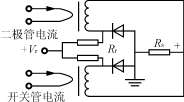
Figure 6 Current Transformer Combination Using Synthetic Inductor Current
3 Current transformer design method
The current transformer ratio n is determined according to the primary current i1 and the secondary output voltage Um; the magnetic core can be selected from a ferrite material having a large initial permeability, and the size is determined according to the effective area of ​​the magnetic circuit. Can be selected according to formula (3)
Ae=
Where: Ae is the effective cross-sectional area of ​​the magnetic circuit;
Um is the maximum voltage of the secondary side of the current transformer;
N is the number of turns of the secondary side coil;
B is the maximum working magnetic flux of the magnetic core, generally taken as 1/2 to 1/3 of the saturation magnetic flux;
Fs is the primary side pulse current frequency.
Rs is obtained from the maximum voltage Um of the secondary side and the current IR. The value of Rr is much larger than Rs, which may be 50 to 100 times of Rs. The specific size can be adjusted according to the experimental results.
4 Experimental results
1) In the Boost circuit, the self-reset current transformer is used to detect the switching tube current and is supplied to the control circuit current feedback loop. The magnetic core is made of manganese-zinc ferrite, the effective cross-sectional area of ​​the magnetic circuit is 0.25mm2, the transformation ratio is 100, and the sampling resistance is 3.9 Ω. The switching frequency is 20 kHz, the primary current of the current transformer is 3.6 A, and the maximum duty is 0.45. The experimental waveform is shown in Figure 7.

(a) Secondary voltage um waveform

(b) Sampling resistor voltage uR waveform
Figure 7 Experimental waveform
2) In the bipolar SPWM inverter circuit, the DC bus flows through the positive and negative asymmetrical bipolar current pulses, and is detected by the forced reset current transformer, and the overcurrent and through protection circuits are provided. The magnetic core is made of manganese-zinc ferrite, the core has a cross-sectional area of ​​0.35 mm2, a transformation ratio of 100, and a sampling resistance of 16 Ω. The switching frequency is 20kHz, the inverter output sine wave frequency is 50Hz, the primary current of the current transformer is 3A, and the maximum duty ratio is 0.95. The experimental waveforms in one switching cycle and one power frequency cycle are shown in Figures 8 and 9, respectively.

(a) Secondary voltage um waveform

(b) Sampling resistor voltage uR waveform
Figure 8 Waveform during a switching cycle

(a) Secondary voltage um waveform
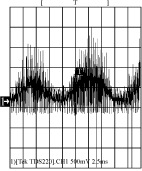
(b) Sampling resistor voltage uR waveform
Figure 9 waveform in a power frequency cycle
5 Conclusion
This paper analyzes the working process of self-reset and forced reset current transformer to detect unipolar DC pulse, draws the waveform of the circuit in one pulse period, compares the characteristics of various circuit core reset, and briefly introduces The design method of current transformers. The test results verify the correctness of the analysis.
Led Street Lamp,Street Light,Led Garden Lights,Outdoor Garden Lights
ZHEJIANG TIANHONG LITHIUM-ION BATTERY CO.,LTD , https://www.tflbattery.com